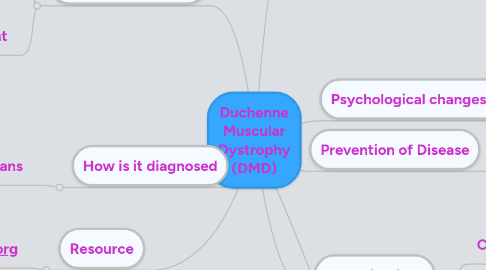
1. How is it diagnosed
1.1. Largest ever found in humans
1.1.1. DNA sequencing
2. Resource
2.1. www.duchenneconnect.org
3. Etiology or Risk Factors
3.1. Male
3.1.1. Passed on by the X chromosome
3.1.2. Most common Sex linked, recessive inheritance
3.1.2.1. Able to skip generations
3.1.2.1.1. Females are carriers, because they have 2 X chromsomes, the good one presents and trait is not expressed
3.1.2.2. Must come from Mom
3.1.2.2.1. Dad only passed the Y chromosome
4. Medical Treatments
4.1. Progressive, incurable disease
4.2. Medications
4.2.1. Steriods
4.2.1.1. Slow down the progressive degeneration of the muscles
4.2.1.1.1. Temporary 6 mo - 2 yrs
4.3. Medical Equipment
4.3.1. Leg braces
4.3.2. Wheelchair
4.3.2.1. Mobility
4.3.2.1.1. Independence
5. Signs & Symptoms
5.1. Presence of the DMD gene on the X chromosome
5.2. Absence of dystrophin
5.2.1. Protein involved in muscle structure
5.3. Progressive, muscular degeneration
5.3.1. slow to walk in childhood
5.3.2. Easily falls during childhood and up to time complete inmobility of legs
5.3.2.1. Usually naturally by age 13, but with steriod treatment many are able to walk until their 20s
5.3.3. Difficulty lifting arms
6. Psychological changes in the body
6.1. Disrupts the normal development of the muscular cell, leading to compromisible wall.
7. Complications
7.1. Cardiac failure
7.1.1. Myocardium weakens and heart is unable to pump adequately
7.1.1.1. Death
7.2. Respiratory failure
7.2.1. Accessory muscles degenerate and are not able to support the lungs
8. Prevention of Disease
8.1. Determine linkage within the family
8.1.1. Creation of a Pedigree
